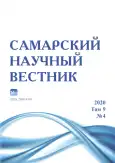Ecological and coenotic groups of Orenburg Region vascular plants flora and biotopes phytoindication
- Authors: Nazarenko N.N.1, Pohlebaev S.M.1, Malaev A.V.1, Tretyakova I.A.1, Khodzhayev A.K.1
-
Affiliations:
- South Ural State Humanitarian Pedagogical University
- Issue: Vol 9, No 4 (2020)
- Pages: 109-120
- Section: General Biology
- URL: https://journals.rcsi.science/2309-4370/article/view/59440
- DOI: https://doi.org/10.17816/snv202094117
- ID: 59440
Cite item
Full Text
Abstract
The expert and statistical assessment of ecological and coenotic groups of Orenburg Region vascular plants flora has been done for A.L. Bel’gards coenomorphs scheme and scheme of vascular plants flora of temperate forest zone of European Russia. The regimes of principal ecological factors have identified for detected groups of flora. Both suggested schemes of groups give adequate and similar assessment of biotopes, proposed groups of Orenburg Region vascular plants flora are identified in phytometer scales space definitely and its groups can used for regional assessment of biotopes. It has been established, that steppe coenomorph has extensive coenotic amplitude in Orenburg Region conditions and make petrophilic, chasmophilic, mountain and semi-desert vegetation elements also. Sylvant coenomorph has formed boreal and nemoral sciophytes and heliosciophytes and coenotic group of semiarid steppe forests has not specific biotopic and coenotic value. Pratal coenomorph has been made up humidity-meadow flora, dry-meadow coenotic group is not specific. For Orenburg Region is recommends using unite pratal (meadow) and paludal coenomorphs and separation coenotic group of oligotrophic bogs and ruderal coenomorph, the separation of mountain coenotic group is not confirmed statistical. The best assessment of ecological flora of region are realize by combined coenomorphs and coenotic group schemes approach at the same time. It has been established methodical problems of statistical methods using by phytoindication, problems of «transitional» coenotic groups and problem of wood species assessment in phytometer scales, which are require further researches.
Full Text
##article.viewOnOriginalSite##About the authors
Nazar Nikolayevich Nazarenko
South Ural State Humanitarian Pedagogical University
Author for correspondence.
Email: nnazarenko@hotmail.com
doctor of biological sciences, professor of Chemistry, Ecology and Chemistry Methodology Department
Russian Federation, ChelyabinskSergei Mikhailovich Pohlebaev
South Ural State Humanitarian Pedagogical University
Email: istina48@mail.ru
doctor of pedagogical sciences, professor of General Biology and Physiology Department
Russian Federation, ChelyabinskAleksandr Vladimirovich Malaev
South Ural State Humanitarian Pedagogical University
Email: malaev2@mail.ru
candidate of geographical sciences, head of Geography and Geography Methodology Department
Russian Federation, ChelyabinskIrina Anatolyevna Tretyakova
South Ural State Humanitarian Pedagogical University
Email: tretyakovaia@cspu.ru
candidate of biological sciences, associate professor of General Biology and Physiology Department
Russian Federation, ChelyabinskAskhat Koblanovich Khodzhayev
South Ural State Humanitarian Pedagogical University
Email: drago210@bk.ru
student of Natural Sciences and Technologies Faculty
Russian Federation, ChelyabinskReferences
- Чибилёв А.А. Природное наследие Оренбургской области. Оренбург: Оренбургское книжное издательство, 1995. 172 с.
- Бельгард А.Л. Лесная растительность юго-востока УССР. К.: КГУ, 1950. 263 с.
- Матвеев Н.М. Биоэкологический анализ флоры и растительности (на примере лесостепной и степной зоны). Самара: Издательство «Самарский университет», 2006. 311 с.
- Тарасов В.В. Флора Дніпропетровської і Запорізької областей. Видання друге. Доповнене та виправлене. Дніпропетровськ: Ліра, 2012. 296 с.
- Рябинина З.Н., Князев М.С. Определитель сосудистых растений Оренбургской области. М.: Товарищество научных изданий КМК, 2009. 758 с.
- Назаренко Н.Н., Пасечнюк Е.Ю. Различные методические подходы к классификации эколого-ценотических групп (на примере флоры сосудистых растений Ханты-Мансийского автономного округа – Югра) // Acta Biologica Sibirica. 2019. Т. 5, № 2. С. 119–133.
- Восточноевропейские леса: история в голоцене и современность. Кн. 1 / под ред. О.В. Смирновой. М.: Наука, 2004. 479 с.
- Расширенная система эколого-ценотических групп видов сосудистых растений для бореальной, гемибореальной и умеренной лесных зон Европейской России (2008) [Электронный ресурс] // https://www.impb.ru/index.php?id=div/lce/ecg.
- Смирнов В.Э., Ханина Л.Г., Бобровский М.В. Обоснование системы эколого-ценотических групп видов растений лесной зоны Европейской России на основе экологических шкал, геоботанических описаний и статистического анализа // Бюллетень МОИП. Отдел биологический. 2006. Т. 111, вып. 2. С. 36–47.
- Смирнов В.Э. Функциональная классификация растений методами многомерной статистики // Математическая биология и информатика. 2007. Т. 2, № 1. С. 1–17.
- Didukh Ya.P. The ecological scales for the species of Ukrainian flora and their use in synphytoindication. Kyiv: Phytosociocentre, 2011. 176 p.
- Назаренко Н.Н. Ценоморфы флоры степной зоны Южного Урала (на примере Челябинской области) // Вестник Тамбовского университета. Серия: Естественные и технические науки. 2016. Т. 21, вып. 5. С. 1889–1896.
- Дрогунова М.С., Назаренко Н.Н. Ценоморфы флоры Тамбовской области и фитоиндикация биотопов // Вестник Тамбовского университета. Серия: Естественные и технические науки. 2017. Т. 22, вып. 5. С. 780–786.
- Назаренко Н.Н. Ценоморфы как фитоиндикаторы биотопов // Вісник Дніпропетровського університету. Біологія, екологія. 2016. Вип. 24, Т. 1. С. 8–14.
- Назаренко Н.Н., Похлебаев С.М. Эколого-ценотические группы (ценоморфы) А.Л. Бельгарда – Н.М. Матвеева для лесостепи и степи Поволжского региона // Самарский научный вестник. 2020. Т. 9, № 1 (30). С. 79–84.
- Терентьев П.В. Применение метода итераций в количественном учете животных // Применение математических методов в биологи. Л.: ЛГУ, 1964. С. 105–110.
Supplementary files








